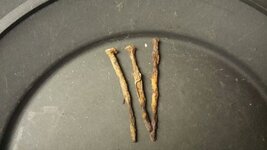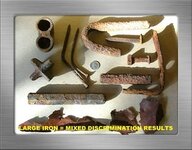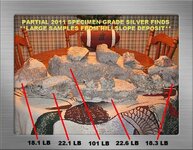Navigation
Install the app
How to install the app on iOS
Follow along with the video below to see how to install our site as a web app on your home screen.
Note: This feature may not be available in some browsers.
More options
You are using an out of date browser. It may not display this or other websites correctly.
You should upgrade or use an alternative browser.
You should upgrade or use an alternative browser.
Square Nails and Gold In Topsoil
- Thread starter Aufisher
- Start date
Lanny in AB
Gold Member
- Apr 2, 2003
- 5,670
- 6,412
- Detector(s) used
- Various Minelabs(5000, 2100, X-Terra 705, Equinox 800, Gold Monster), Falcon MD20, Tesoro Sand Shark, Gold Bug Pro, Makro Gold Racer.
- Primary Interest:
- Prospecting
Jim Hemmingway
Hero Member
- Jan 26, 2008
- 791
- 1,624
- Detector(s) used
- F-75, Infinium LS, MXT, GoldBug2, TDI Pro, 1280X Aquanaut, Garrett ProPointer
- Primary Interest:
- Prospecting
Hello Aufisher... these square nails plus that oldtimer’s pick blade you displayed awhile back have you well on your way to a good relic collection. I keep samples of different types of nails and other iron pieces found in the field and use many for testing on my PI and VLF units. Nails don't bother me much in the field, either I ignore them or remove them… one by one… if I think I'm over productive ground.
The photo below displays only a few of the many iron items I’ve found and packed home… in part because I see their history. I’m never in too much of a hurry not to take a moment to pack-up some relics of yesteryear, and I doubt you are much different from me in that respect. Good luck and good hunting.
Jim.
The photo below displays only a few of the many iron items I’ve found and packed home… in part because I see their history. I’m never in too much of a hurry not to take a moment to pack-up some relics of yesteryear, and I doubt you are much different from me in that respect. Good luck and good hunting.
Jim.
Aufisher
Bronze Member
- May 12, 2013
- 1,948
- 4,830
- Detector(s) used
- Whites Goldmaster V/SAT. VibraProbe. Bazooka 48" Prospector Sluice. Shorts. Chickens + Goats + Goldhounds. 35' Chris Craft Caribbean motorsailer. FISH OIL + BURLAP
- Primary Interest:
- Prospecting
- Thread starter
- #4
Thank you Jim! I do treasure my iron collection! You have some great pieces!! Thanks for sharing. Happy hunting sir!
Jim Hemmingway
Hero Member
- Jan 26, 2008
- 791
- 1,624
- Detector(s) used
- F-75, Infinium LS, MXT, GoldBug2, TDI Pro, 1280X Aquanaut, Garrett ProPointer
- Primary Interest:
- Prospecting
Aufisher… a few more comments after thinking about this thread for awhile.
It seems to me that I’ve spent a disproportionate amount of time over the years testing how metal detectors and coil combinations react to variable iron shapes and sizes, and to variable iron mineralizations encountered while metal detecting in different areas across the country. In either form, my initial reaction is that iron is the bane of metal detecting for precious metals. But that is not an entirely complete picture. Iron does have some redeeming attributes or uses, aside from historical significance to relic collectors.
We all realize that over time iron corrodes, forming a rust halo that changes or enhances iron signals such that their target ID can and does differ from what can be expected from benchtested iron, or freshly buried iron targets in a backyard testplot. So from a practical standpoint, mining camp iron trash at variable depths is ideal to test and evaluate detector / coil combinations over real-world ground conditions and mineralizations for meaningful results.
Second, I think that iron-infested areas in prime silver hunting country here in Ontario are a blessing because proliferate iron signals effectively conceal valuable silver ores. Without the iron junk, readily accessible mining camps would soon be stripped of detectable near-surface silver.
And third, in our heavily forested outback, patches of iron trash alert you to sites of past activity that might otherwise be overlooked…sites long since obscured by encroaching forest cover. But there’s no mistaking abundant iron signals. These are a tip-off to search for relics and bottles…particularly bottles on the downside of the nearest hillslope. It was such a scenario that led me to a deposit of large silver in the outback a few years ago… handsome silver that might otherwise not have been found. That's it... just a few thoughts to chew on...
Jim.
It seems to me that I’ve spent a disproportionate amount of time over the years testing how metal detectors and coil combinations react to variable iron shapes and sizes, and to variable iron mineralizations encountered while metal detecting in different areas across the country. In either form, my initial reaction is that iron is the bane of metal detecting for precious metals. But that is not an entirely complete picture. Iron does have some redeeming attributes or uses, aside from historical significance to relic collectors.
We all realize that over time iron corrodes, forming a rust halo that changes or enhances iron signals such that their target ID can and does differ from what can be expected from benchtested iron, or freshly buried iron targets in a backyard testplot. So from a practical standpoint, mining camp iron trash at variable depths is ideal to test and evaluate detector / coil combinations over real-world ground conditions and mineralizations for meaningful results.
Second, I think that iron-infested areas in prime silver hunting country here in Ontario are a blessing because proliferate iron signals effectively conceal valuable silver ores. Without the iron junk, readily accessible mining camps would soon be stripped of detectable near-surface silver.
And third, in our heavily forested outback, patches of iron trash alert you to sites of past activity that might otherwise be overlooked…sites long since obscured by encroaching forest cover. But there’s no mistaking abundant iron signals. These are a tip-off to search for relics and bottles…particularly bottles on the downside of the nearest hillslope. It was such a scenario that led me to a deposit of large silver in the outback a few years ago… handsome silver that might otherwise not have been found. That's it... just a few thoughts to chew on...
Jim.
Aufisher
Bronze Member
- May 12, 2013
- 1,948
- 4,830
- Detector(s) used
- Whites Goldmaster V/SAT. VibraProbe. Bazooka 48" Prospector Sluice. Shorts. Chickens + Goats + Goldhounds. 35' Chris Craft Caribbean motorsailer. FISH OIL + BURLAP
- Primary Interest:
- Prospecting
- Thread starter
- #6
Great points sir! What a treat to see that silver ore! Nature is quite amazing and man's junk piles are a great indicator of past presence. Too bad they didn't line sardine cans with gold! Happy hunting!
Top Member Reactions
-
 3507
3507 -
 1992
1992 -
 1895
1895 -
 1164
1164 -
 1069
1069 -
 1012
1012 -
 877
877 -
 873
873 -
 849
849 -
 785
785 -
 763
763 -
 665
665 -
 660
660 -
 571
571 -
 508
508 -
 450
450 -
 439
439 -
 404
404 -
E
401
-
 397
397
Users who are viewing this thread
Total: 2 (members: 0, guests: 2)








